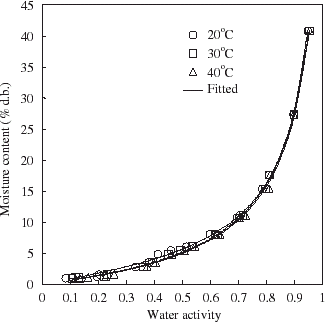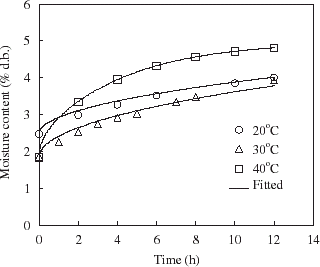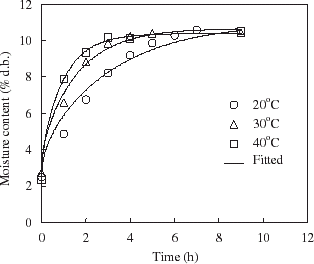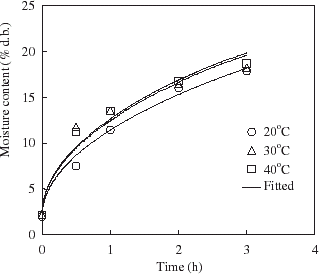Abstract
Equilibrium moisture sorption isotherms of fried cassava-shrimp chips were investigated by measuring water activity at 20, 30, and 40°C for modeling transient diffusion of moisture. The sorption isotherms followed a type III shape in water activity range of 0.1–0.9 showing negligible influence of temperature, and were best represented by the GAB, Henderson, and modified Henderson equations. Effective moisture diffusivity of chips based on analytical solution of Fick's law ranged from 0.8 × 10−11 to 2.1 × 10−10 m2/s during exposure to fixed relative humidity (50, 70, and 90%) and temperature (20, 30, and 40°C) environments. An Arrhenius type relationship adequately described the dependence of effective moisture diffusivity both on temperature and relative humidity, and led to good agreement between experimental and estimated transient moisture sorption data.
Introduction
Fried cassava-shrimp chips (Khao Kriap) are popular snack foods in Thailand and other Southeast Asian countries. They are prepared traditionally by gelatinizing the dough formed from a mixture of tapioca flour, water, and flavoring with spices. Other nutritional ingredients such as fish, shrimp, or vegetables are usually added to produce various types of chips.Citation1 The dough is rolled and cut into thin slices for drying subsequently to produce an intermediate product. Frying of slices in hot oil transforms them into expanded and light textured cassava-shrimp chips. Fried cassava-shrimp chips are classified as quick fried snack foods based on the process technology associated with their manufacture.Citation2 Therefore, the quality of chips may be adversely affected by the presence of oxygen and moisture during storage. Oxygen promotes the oxidation of the oils absorbed during frying and results in rancid off-flavor. In addition, moisture gain by the chips during storage may destroy the crisp texture and lead to rejection by consumers.Citation3
Moisture exchange between the food and the environment is one of the basic physical phenomena occurring in foods during processing and storage.Citation4 Citation5 The properties of foods are mainly affected by the amount of water present in any location in the foods. Water activity affects microbial spoilage, enzymatic reactions, and lipid oxidation as well as moisture sorption rate in food products.Citation6 Normally, the relationship between equilibrium moisture content (m e ) and water activity (a w ) is presented in the form of either adsorption or desorption isotherm and described in terms of mathematical models. For example, Palou et al.Citation7 described the moisture sorption characteristics of cookies and corn snacks with Peleg's and GAB models. LewickiCitation8 developed a three-parameter equation for moisture isotherms and fitted to thirty-one food sorption isotherms. Moisture sorption isotherms of composite foods filled with chocolate were determined and fitted with GAB equation by Kim et al.Citation9 In addition, many researchers have studied moisture transfer in food materials in conjunction with equilibrium moisture isotherms. For example, Lomauro et al.Citation4 reported moisture transfer properties of dry and semi-moist foods. Sorption and diffusion properties of peeled almond were determined by Ruiz-Bevia’ et al.Citation10 Phoungchandang and WoodsCitation11 presented desorption isotherms and moisture diffusion during drying for whole peeled banana.
Fried cassava-shrimp chips are known to deteriorate during storage mainly by moisture gain. In order to optimize the shelf-life of the fried cassava-shrimp chips, data on moisture sorption isotherms and diffusion characteristics are needed. However, no such information is available for fried cassava-shrimp chips in the published studies. Therefore, the main objectives of this study were the determination of moisture sorption isotherms of fried cassava-shrimp chips and modeling of moisture transfer during storage at different temperatures and relative humidities.
Materials and Methods
Sample Preparation
Commercially available fried cassava-shrimp chips (Manora® brand) were used in this study. The average major ingredients of the chips were fresh shrimp (35%), cassava flour (45%), garlic (5%), pepper (1.5%), and monosodium glutamate (1%). The chips were obtained directly from a local food processor (Manora Foods Industry Co., Ltd., Bangkok, Thailand). The information on proximate composition of chips was also available.
The samples were conditioned by exposing to ambient air approximately at 25–30°C and 65–70% relative humidity (RH), and in a humidity controlled chamber (WTC Binder, Germany) at 30°C and 90% RH to attain intermediate and high moisture contents, respectively based on predetermined weight gains. Finally the chips were ground using an electric food blender and stored in glass jars at ambient temperature for three days to attain equilibrium conditions prior to determining m e and a w .
Determination of Equilibrium Moisture Sorption Isotherms
The moisture sorption isotherms of fried cassava-shrimp chips were determined by direct measurement of a w of samples conditioned to different moisture levels.Citation6 Duplicate samples (weighing approximately 3 g) were used for a w measurements at 20, 30, and 40°C by a CX-2 Water Activity System (Decagon Devices, Pullman, WA) providing ± 0.003 accuracy for its readings. Because the cooled mirror dew point technique which is the primary measurement method of relative humidity is applied to measure a w , no calibration is necessary for this instrument according to its manual. However, the linear offset was verified before a w measurements by standard saturated salt solutions corresponding to the a w of about 0.1 (LiCl2), 0.8 (NaCl), and 1.0 (distilled water) at each temperature to assure the correctness of readings. Moisture content determination was based on the drying of ground samples weighing approximately 5 g in an oven at 105°C overnight.Citation12 Later moisture sorption isotherms were obtained from the relationships between a w and moisture content.
Determination of Transient Moisture Diffusion in Chips
Fried cassava-shrimp chips weighing approximately 5 g were placed in five separate Petri dishes for exposure in a controlled environment chamber using nine different combinations of preselected temperature (20, 30, and 40°C) and RH (50, 70, and 90%). The weight gain by the samples was recorded at known time intervals, and used for calculating the moisture content during exposure. The initial moisture content of samples was determined by the oven method as described earlier. The thickness of 30 chips was also measured using a micrometer.
Data Analysis
Equilibrium Moisture Sorption Isotherm Models
The following five isotherm models were selected to check their applicability to represent the experimental data:
GAB equationCitation13 Citation14:
Henderson equationCitation15:
Modified Henderson equation,Citation13 Citation16 andCitation17:
Modified Halsey equationCitation18:
Modified Oswin equationCitation19:
All isotherm models were arranged to express m e as a function of a w . The parameters of the selected models were computed using nonlinear regression procedure available in SPSS.Citation20 The goodness of fit of different models was investigated using three criteriaCitation13 Citation21 described as mean sum of squares of residuals (MSE),Citation13 mean relative percentage deviation (P)Citation13 Citation16 and the plot of residual pattern.
Determination of Moisture Diffusivity
The analytical solution of Fick's second law for the diffusion of moisture in one dimension across an infinite slab assuming uniform initial moisture content, constant surface moisture content in equilibrium with surrounding environment, negligible external resistance at the surface and constant diffusivity leads to Eq. (Equation6)Citation4 Citation22:
It is also assumed that shrinkage in the product due to moisture adsorption is negligible. The values of effective moisture diffusivity, D in Eq. (Equation6) were determined by a computer program for implementing nonlinear least-squares regression using Newton-Raphson method based on first 60 terms of the series solution.Citation23
ResultS and Discussion
Composition of Fried Cassava-Shrimp Chips
Average proximate composition of fried cassava-shrimp chips was carbohydrates (54.3%), fat (27.2%), protein (10.2%), fiber (1.6%), and ash (3.4%) on dry basis as shown in Table . A comparison of the compositions of fried cassava-shrimp chips and commercially available potato and corn chipsCitation24 as shown in Table indicated obvious similarities in the proportions of major components such as carbohydrates, fat, and protein.
Table 1 Proximate composition of experimental fried cassava-shrimp chips and selected commercially available chips (% dry basis)
Moisture Sorption Isotherms
The sorption isotherm data of fried cassava-shrimp chips at 20, 30, and 40°C are presented in Table . The isotherms (Fig. ) exhibited a smooth shape resembling to type III classification,Citation25 Citation26 which is commonly obtained for foods with high fat content.Citation27 Apparently, the equilibrium moisture content increased slowly over lower range of a w and showed a steep rise thereafter at higher a w levels most possibly because of hydrophobic nature of the chips due to their high fat content.Citation27 It can be seen that the moisture sorption isotherms were not influenced by temperature over a w range of 0.1–0.9. These results are similar to moisture adsorption isotherms reported previously in literature for foods such as garlicCitation28 and pistachio nut paste.Citation29
Figure 1. Moisture sorption isotherms of fried cassava-shrimp chips showing experimental data and fitted relationships based on GAB equation.

Table 2 Moisture content (m e ) and water activity (a w ) of fried cassava-shrimp chips
Analysis of variance showed that there were no significant differences (p < 0.05) between the experimental and estimated values of the equilibrium moisture contents for the selected five moisture sorption isotherm models. Also no significant differences were found among the equilibrium moisture contents estimated by all five models. However, the GAB, Henderson, and modified Henderson equations best described the sorption isotherms with relatively low values of standard error of estimation (SEE), MSE, and P along with high values of coefficient of determination (R 2) as showed in Table . The residuals from these models were also scattered randomly. In contrast, the fitting by the modified Oswin and modified Halsey equations resulted in residual plots exhibiting a pattern in data. Therefore, these models were considered inadequate for describing the sorption isotherms of fried cassava-shrimp chips. A comparison of experimental and estimated equilibrium moisture contents based on the GAB equation indicating a good overall fit is presented in Fig. .
Table 3 Parameters and related statistics for five moisture sorption models fitted to experimental data
Moisture Sorption Characteristics
The estimated values of D for fried cassava-shrimp chips based on the fitting of analytical series solution for infinite slab (Eq. (6)) to the experimental moisture sorption data are presented in Table . The equilibrium moisture contents (m e ) of chips estimated by GAB equation (Eq. (1)) are also shown in Table . The D values ranged approximately from 0.8 × 10−11 to 2.1 × 10−10 m2/s. LabuzaCitation6 reported that D values could range from 1.0 × 10−13 to 1.0 × 10−8 m2/s for most freeze-dried foods. Thus, the moisture diffusivity of fried cassava-shrimp chips fell within the normally expected range of D for other food products.
Table 4 Moisture diffusivity (D) of fried cassava-shrimp chips, mean relative percentage deviation (P), and R 2 determined from moisture sorption experiments
It was also apparent from Table that an increase in both air temperature and RH resulted in higher values of D signifying a corresponding increase in the rate of moisture sorption. The dependence of D on temperature was expressed using the Arrhenius equationCitation30:
Fitting of Eq. (Equation7) to experimental data at different RH levels indicated the R 2 values higher than 0.9. Both E a and A a decreased with an increase in RH. Further, analysis showed that moisture diffusivity was best estimated by Eq. (Equation7) (R 2 > 0.96) using nonlinear regression based on the following relationships:
The activation energy, E a decreased from about 70.3 to 13.8 kJ/mol when the RH increased from 50 to 90%. A comparison of experimental and estimated values of D based on Eq. (Equation7) indicated a very good agreement as shown in Table . These results confirmed that diffusion of moisture in fried cassava-shrimp chips depended on both temperature and relative humidity of the surrounding environment. Previous studies have reported that moisture diffusion in banana,Citation11 rough rice,Citation31 and parboiled polished riceCitation32 is mainly temperature dependent, and could be represented by the Arrhenius equation. Also it has been shown that both temperature and moisture content might have significant effects on the moisture diffusivity of some foods when fitting Arrhenius equation to the experimental data.Citation33 Thus, the composition and porous structure of fried cassava-shrimp chips could be responsible for the dependence of moisture diffusivity both on temperature and RH.
Figures , , show a close relationship between experimental and estimated values of moisture contents of fried cassava-shrimp chips during exposure to various constant RH and temperature conditions. These results revealed the validity of Eq. (Equation6) to describe the moisture transfer characteristics of the chips. Because of the porous structure, high surface area and very small thickness of the chips, moisture diffusion was predominately across the chips, and the effect of moisture diffusion along the edges could be neglected. At any given RH, moisture absorption by the chips increased with an increase in temperature at all exposure times. However, higher moisture contents attained by the chips when exposed to 50% RH at 20°C as compared to 30°C in Fig. were primarily due to higher initial moisture content of the samples. The values of mean relative percentage deviation (P) and R 2 for various moisture absorption plots are presented in Table to indicate the good overall fitting.
Figure 2. Comparison of experimental and estimated moisture contents of fried cassava-shrimp chips during storage at different temperatures and 50% RH.

Conclusions
Equilibrium moisture sorption isotherms and moisture transfer characteristics of fried cassava-shrimp chips were described accurately by the developed mathematical models. The moisture sorption isotherms resembled type III shape and exhibited little influence of temperature over the water activity (a w ) range of 0.1–0.9. The GAB, Henderson, and modified Henderson equations estimated the equilibrium moisture content of chips as a function of a w with good accuracy. Analytical solution of Fick's law for one-dimensional moisture diffusion in a semi-infinite slab could be used for estimating the sorption of moisture by fried cassava-shrimp chips during exposure to different temperature (T) and relative humidity (RH) environments. The effective moisture diffusivity (D) ranged from 2.1 × 10−10 to 0.8 × 10−11 m2/s, and was well within the range of reported values for porous food products. In addition, Arrhenius type relationship existed between D and T at any given RH, and indicated a distinct decrease in the magnitude of equation parameters with increasing RH.
Nomenclature
| A | = |
Constant |
| A a | = |
Constant (m2/s) |
| B | = |
Constant |
| C | = |
Constant |
| a w | = |
Water activity (decimal) |
| D | = |
Effective moisture diffusivity (m2/s) |
| E a | = |
Activation energy (kJ/mol) |
| L | = |
Half-thickness of the slab (m) |
| m | = |
Moisture content at time t ((kg water/kg dry solid) × 100) |
| m o | = |
Initial moisture content ((kg water/kg dry solid) × 100) |
| m e | = |
Equilibrium moisture content ((kg water/kg dry solid) × 100) |
| m m | = |
Monolayer moisture content ((kg water/kg dry solid) × 100) |
| MSE | = |
Mean sum of squares of residuals |
| n | = |
Number of terms |
| P | = |
Mean relative percentage deviation |
| R | = |
Universal gas constant (8.314 × 10−3 kJ/mol K) |
| R 2 | = |
Coefficient of determination |
| RH | = |
Relative humidity (decimal) |
| SEE | = |
Standard error of estimation |
| t | = |
Time (s) |
| T C | = |
Temperature (°C) |
| T K | = |
Absolute temperature (K) |
References
- Lakleang , S. 1991 . “ Quality and process improvements of cassava cracker. Thesis (M.Sc. Agro-Industrial Product Development) ” . 252 Bangkok, , Thailand : Kasetsart University .
- Reilly , A. and Man , C.M.D. 1996 . “ Potato crisps and savory snacks ” . In Shelf Life Evaluation of Foods 202 – 215 . Glasgow, , UK : Blackie Academic & Professional .
- Yu , S.Y. 1991 . Acceptability of fish crackers (Keropok) made from different types of flour . ASEAN Food Journal , 6 ( 3 ) : 114 – 116 .
- Lomauro , C.J. , Bakshi , A.S. and Labuza , T.P. 1985 . Moisture transfer properties of dry and semimoist foods . Journal of Food Science , 50 ( 2 ) : 397 – 400 .
- Doulia , D. , Tzia , K. and Gekas , V. 2000 . A knowledge base for the apparent mass diffusion coefficient (D eff) of foods . International Journal of Food Properties , 3 ( 1 ) : 1 – 14 .
- Labuza , T.P. 1984 . Moisture Sorption: Practical Aspects of Isotherm, Measurement and Use 149 pp Minnesota, , USA : American Association of Cereal Chemists .
- Palou , E. , Lo’pez-Malo , A. and Argaiz , A. 1997 . Effect of temperature on the moisture sorption isotherms of some cookies and corn snacks . Journal of Food Engineering , 31 ( 1 ) : 85 – 93 . [CROSSREF]
- Lewicki , P.P. 1998 . A three parameter equation for food moisture sorption isotherms . Journal of Food Process Engineering , 21 ( 1 ) : 127 – 144 .
- Kim , S.S. , Kim , S.Y. , Kim , D.W. , Shin , S.G. and Chang , K.S. 1999 . Moisture sorption characteristics of composite foods filled with chocolate . Journal of Food Science , 64 ( 2 ) : 300 – 302 .
- Ruiz-Bevia , F. , Ferna’ndez-Sempere , J. , Go’mez-Siurana , A. and Torregrosa-Fuerte. 1999 . Determination of sorption and diffusion properties of peeled almond nuts . Journal of Food Engineering , 41 ( 3 ) : 209 – 214 . [CROSSREF]
- Phoungchandang , S. and Woods , J.L. 2000 . Moisture diffusion and desorption isotherms for banana . Journal of Food Science , 65 ( 4 ) : 651 – 657 .
- Pinthus , E.J. , Weinberg , P. and Saguy , I.S. 1995 . Oil uptake in deep fat frying as affected by porosity . Journal of Food Science , 60 ( 4 ) : 767 – 772 .
- Ertugay , M.F. , Cartel , M. and Gurses , A. 2000 . Moisture adsorption isotherms of tarhana at 25°C and 35°C and the investigation of fitness of various isotherm equations to moisture sorption data of tarhana . Journal of the Science of Food and Agriculture , 80 : 2001 – 2004 . [CSA] [CROSSREF]
- Kuye , A. and Sanni , L.O. 2002 . Modelling sorption isotherms of lafun and soyflour using a spreadsheet . International Journal of Food Properties , 5 ( 3 ) : 599 – 610 . [CROSSREF]
- Lim , L.T. , Tang , J. and He , J. 1995 . Moisture sorption characteristics of freeze dried blueberries . Journal of Food Science , 60 ( 4 ) : 810 – 814 .
- Thompson , T.L. , Peart , R.M. and Foster , G.H. 1969 . Mathematical simulation of corn drying—a new model . Transactions of the ASAE , 11 ( 4 ) : 582 – 586 .
- Mazza , G. , Jayas , D.S. , Oomah , B.D. and Mills , J.T. 1994 . Comparison of five three-parameter equations for the description of moisture sorption data of mustard seeds . International Journal of Food Science and Technology , 29 ( 1 ) : 71 – 81 . [CSA]
- Iglesias , H.A. and Chirife , J. 1976 . Prediction of effect of temperature on water sorption isoterms of food materials . Journal of Food Technology , 11 ( 1 ) : 109 – 116 .
- Chen , C. and Morey , R.V. 1989 . Comparison of four EMC/ERH equations . Transactions of the ASAE , 10 ( 4 ) : 552 – 555 .
- SPSS. 1998 . SPSS for Windows, , Version 10.0.7 Chicago, IL : SPSS Inc. .
- Sopade , P.A. 2001 . Criteria for an appropriate sorption model based on statistical analysis . International Journal of Food Properties , 4 ( 3 ) : 405 – 418 . [CROSSREF]
- Crank , J. 1975 . The Mathematics of Diffusion, , 2nd Ed. London : Oxford University Press .
- Jindal , V.K. 2000 . A BASIC Program for Determining Moisture Diffusivity from the Analytical Series Solution Fick's Second Law Using Newton-Raphson Approach Bangkok : Asian Institute of Technology .
- Moreira , R.G. , Castell-Perez , M.E. and Barrufet , M.A. 1999 . Deep-Fat Frying: Fundamentals and Applications 349 pp USA : Aspen Publishers, Inc. .
- Rahman , S. 1995 . Food Properties Handbook 500 pp New York, , USA : CRC Press .
- Brunauer , S. , Emmett , P.H. and Teller , E. 1938 . Adsorption of gases in multimolecular layers . Journal of American Chemistry Society , 60 ( 1 ) : 309 – 319 .
- Sopade , P.A. , Ajisegiri , E.S. and Abass , A.B. 1995 . Moisture sorption isotherms of kilishi, a traditional Nigerian meat product . ASEAN Food Journal , 10 ( 1 ) : 30 – 37 .
- Pezzutti , A. and Crapiste , G.H. 1997 . Sorptional equilibrium and drying characteristics of garlic . Journal of Food Engineering , 31 ( 1 ) : 113 – 123 . [CROSSREF]
- Maskan , M. and Gogus , F. 1997 . The fitting of various models to water sorption isotherms of pistachio nut paste . Journal of Food Engineering , 33 ( 3 ) : 227 – 237 . [CROSSREF]
- Saravacos , G.D. and Maroulis , Z.A. 2001 . Transport Properties of Foods 141 pp New York, , USA : Marcel Dekker, Inc. .
- Steffe , J.F. and Singh , R.P. 1980 . Liquid diffusivity of rough rice components . Transactions of the ASAE , 23 ( 3 ) : 767 – 774 .
- Igathinathane , C. and Chattopadhyay , P.K. 1999 . Moisture diffusion modelling of drying in parboiled paddy components. Part I: starchy endosperm . Journal of Food Engineering , 41 ( 1 ) : 49 – 88 .
- Maroulis , Z.B. , Saravacos , G.D. , Panagiotou , N.M. and Krokida , M.K. 2001 . Moisture diffusivity data compilation for foodstuffs: effect of material moisture content and temperature . International Journal of Food Properties , 4 ( 2 ) : 225 – 237 . [CROSSREF]

